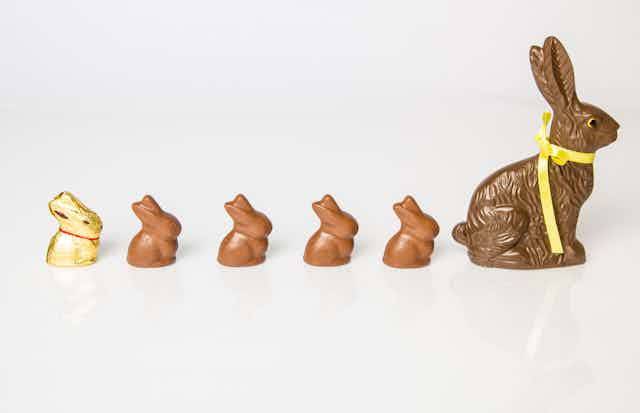Tens of millions of chocolate bunnies get sold in the U.S. every Easter. Here are six articles about chocolate from The Conversation’s archive – great reading while you’re nibbling the ears off your own bunny (if you’re one of the three-quarters of Americans who start at the top).
1. Food scientist on cocoa chemistry
Chocolate bunnies don’t grow on trees – but cacao pods do. It takes a lot of processing to get from the raw agricultural input to the finished output.
Food scientist Sheryl Barringer from The Ohio State University wrote about various chemical reactions that are part of the transformation of beans into chocolate. One is the Maillard reaction, the same thing that gives the browned bits on roasted meats or a bread’s golden crust their flavor. Barringer also explains that weird white stuff – known as bloom – that might appear on your Easter chocolates if they hang around for a while. (Don’t worry, it’s still edible.)
2. Chocolate is a fermented food
Food science Ph.D. candidate Caitlin Clark from Colorado State University focuses her research on the microbes responsible for much of chocolate’s flavor. As a fermented food, chocolate depends on yeast and bacteria to help turn a raw ingredient into the treat you can recognize.
Clark described how the microorganisms that occur naturally in a given geographical location can give high-end chocolates their “terroir” – “the characteristic flair imparted by a place” you might be more used to thinking about with regard to wine.
Read more: Chocolate's secret ingredient is the fermenting microbes that make it taste so good

3. Pollinators are important part of process
Cacao growers rely on another tiny ally to pollinate their crop. Entomologist DeWayne Shoemaker from the University of Tennessee described the mini flies – particularly biting midges and gall midges – that get the job done. “Pollinators must pick up pollen from the male parts of a flower of one tree and deposit it on the female parts of a flower on another tree,” Shoemaker wrote.
But up to 90% of cacao flowers don’t get pollinated at all. People can hand-pollinate the little flowers, but it remains a mystery which other insects might do the job in the wild.
4. Child labor is chocolate’s bitter secret
Harvesting and processing cacao is labor-intensive. To meet this need, some farmers turn to child labor. Cultural anthropologist Robert Ulin from the Rochester Institute of Technology described how the global chocolate industry is tied to inequality via exploitative labor practices.
“The largest chocolate companies signed a protocol in 2001 that condemned child labor and childhood slavery,” Ulin wrote. But he noted that consumers may want more information to make sure their purchase power supports “fair labor practices in the chocolate sector.”
Read more: Some chocolate has a dark side to it – child labor

5. Not safe for furry family members
Eating a ton of chocolate is probably not a healthy choice for anyone. But even a little bit of chocolate can be deadly for dogs and cats.
In an article about all kinds of holiday foods that are unsafe for pets, veterinarian and researcher Leticia Fanucchi from Oklahoma State University explained the chemicals in this human delicacy that can cause fatal “chocolate intoxication.” Don’t delay getting veterinary help if your pet does raid your Easter basket.
6. An enslaved chocolatier in colonial America
An enslaved cook named Caesar, born in 1732, was one of the first chocolatiers in the American colonies. Historical archaeologist Kelley Fanto Deetz from the University of California, Berkeley described how Caesar “would have had to roast the cocoa beans on the open hearth, shell them by hand, grind the nibs on a heated chocolate stone, and then scrape the raw cocoa, add milk or water, cinnamon, nutmeg or vanilla, and serve it piping hot.”
Cocoa was a hot commodity for Virginia’s white elite during this period, when it was a culinary component – along with pineapples, Madeira wine, port, champagne, coffee and sugar – of the Columbian Exchange.
Editor’s note: This story is a roundup of articles from The Conversation’s archives.

